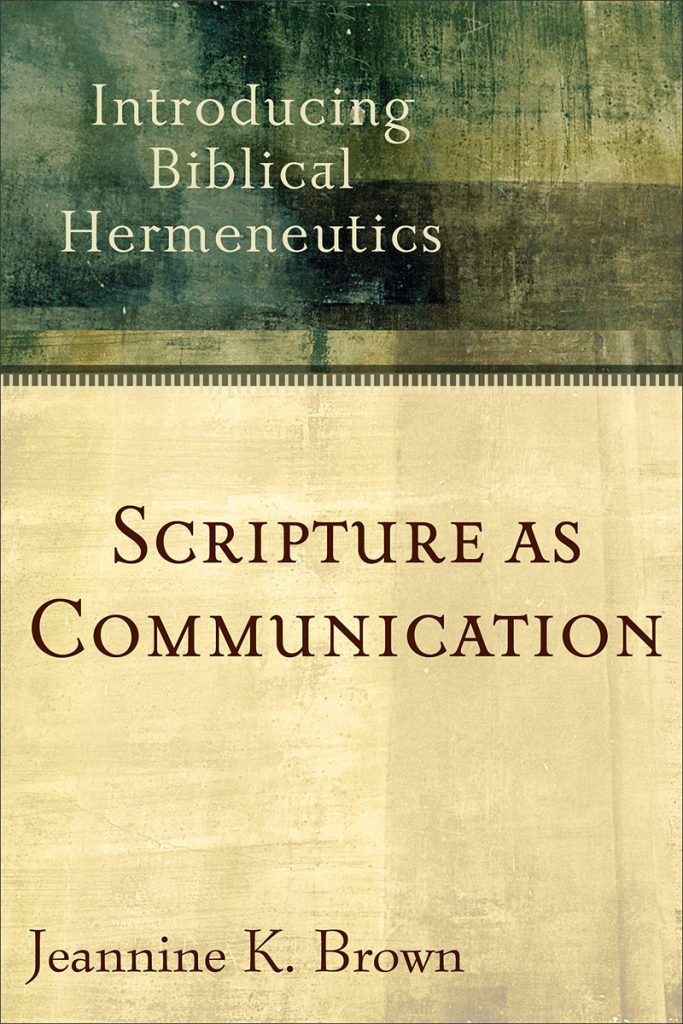Throughout the pages of “Scripture as Communication,” we read and learn about concepts and methods around biblical communication and interpretation. We explore hermeneutical principles and perspectives from various schools of thought. From both a theoretical and practical frame of reference, readers become informed through illustrations, definitions, outlines, and models that educate students of Scripture on what it is to bring about a full and more productive study of God’s word.
Book Review
Contents
Within this book review, various subjects covered among both practical and theoretical sections in Dr. Brown’s book reflect her walkthrough about what interpretation and meaning are and what they involve. Much of Dr. Brown’s use of technical language and prose to guide readers through these subjects is distilled in this review to gain a clear understanding of what a student of Scripture learns within her book about biblical hermeneutics. The first half of the book’s theoretical topics cover the roles of biblical authors, readers, and texts to arrive at conclusions intended for communicative purposes. A reader could view this first section as a survey of internal interest about textual meaning, its implications, historical development, and interest to both readers and authors of Scripture. The second half of the book pertains to practical or external applicability and relevance to what readers understand from the prior section.
Theoretical Perspectives on Scripture as Communication
Terminology & Context
The book begins with definitions and terminology that set up a foundation of understanding within its chapters to follow. Specifically, the author builds upon various terms as new topics are introduced or reinforced. To further understand the definitional meaning of hermeneutics, exegesis, genre, literary context, social setting, and contextualization. These terms become further and progressively explored in-depth to one another. To bring understanding about how they are relevant to the interpretation and application of Scripture as intended.
Dr. Brown defines hermeneutics as the study of activity involving interpretation. It is a meta-textual analysis process that enables a reader or study to arrive at accurate and meaningful conclusions about what becomes communicated. This process gets applied across various genres to interpret and grasp meaning successfully. As readers, we reach an understanding of poetry, narratives, epistles, and legal texts of the Bible. While attending to literary and social contexts in which an author intended. Particularly in their original settings at the time, written works occur for transmission and delivery to readers centuries later.
The introductory topic of exegesis carries more practical relevance in later chapters. However, it is of significant interest from a theoretical perspective because it pertains to the historical context of Scripture as written. Dr. Brown refers to this as an “exegetical process” that is culturally significant concerning a gap between a modern reader and the author of Scripture during the time events, or literary occurrences become committed to text. Exegesis is a practice that a reader applies to get at the closest interpreted meaning of Scripture, most notably concerning its genre, literary context, and social setting.
Communication Models of Interpretation
A greater depth of theoretical understanding becomes developed across numerous models with their historical backgrounds. With examples of their usage, Dr. Brown describes each model in summary and detail. Among the first introduced is speech-act theory while accompanied by language theory, relevance theory, and literary theory. The speech-act theory stands out among all others in Dr. Brown’s further written work among later chapters. In due course, it then becomes necessary to refer back again to the definitions and descriptions associated with this theoretical model to get at its relevance and applicability.
Speech-Act theory calls attention to the functional nature of language. In that, there are specific purposes of language recognized and put to use during a communicative process. There are four critical points of interest — First, a locution as defined by what is said. Second, an illocution to describe what is accomplished by what is said. Third, a perlocutionary intention is an intended response by hearers or readers. Finally, an unintended perlocution is what is accomplished by what is said, but not intended. In an effort to hold together these technical concepts for later reference, students of Scripture can find these terms of limited interest as they appear meant for academics or scholars. Still, the purpose of their definitions within this theoretical model helps to better understand the context of textual work completed thousands of years back in history.
To further draw into the various additional theoretical models of interpretation, Dr. Brown calls attention to their histories, academic contributors, and rationale about their suitability within the exegetical process.
Authors, Texts, Readers
There is a three-way contrast made between each functional role of communicative participants. Introduced are an original author, an implied or actual reader, and an autonomous text that bears its meaning in a free-standing way. It is here that “authorial intention” is introduced as a way to describe and emphasize meaning as best derived from what an author intends or expects. All essential attributes associated with an author such as language, social, economic, and political realities have a bearing on meaning. This meaning, in turn, contributes to the context that conveys understanding, research, application, and contextualization as further explained later in the book.
Further attention has been given to what form of meaning as developed from a reader’s perspective. Where what prevails is the subjective view and preferences of readers with their own biases, traditions, and influences. Over time, this emphasis on a reader’s interpretation to establish meaning has developed but does not hold weight among modern expositors.
Meaning becomes further categorized as intentionality types along a scale or continuum. Between transmissive and expressive intentionality, there are various Scripture genres to bring about outcomes that align with authorial intent — either expressive as apparent among works of poetry, or transmissive and instructional works found among epistles. The Bible’s authors have communicated meaning in their texts to convey intent. Whether in the narrative form or through instructional and emotive style, the method of communication chosen fits the purpose and substance of that which is conveyed. In a context of textual coherence appropriate to what a reader should come to understand and accept.
Developing Textual Meaning
There is a distinction between implicit and explicit meaning as covered by Dr. Brown to probe patterns of communication. Moreover, her book refers to inference beyond explicit intentions. To come closer to what an author intends by written Scripture, we can interpret patterns of meaning that are otherwise less available if we read and understand the Bible at a surface level. This poses certain risks toward false interpretation, but if a reader adheres to literary and historical context according to the purpose of Scripture, they become mitigated or reduced.
Of particular interest is the notion that authors can and do communicate beyond what they consciously express, where there is a (sub)meaning of context which holds validity to a pattern of meaning an author willed or infers. What is striking is that these authors are unaware of meaning and inference, which still carries validity. As explained, an author cannot explicitly attend to all expressive or transmissive meaning toward communicative intent because he or she is unable to pay attention to all aspects of meaning. Inferences and implications, therefore, emerge to further the body of work authors produce to communicate with their readers. Thus, implied meaning from New Testament sources compared to implied meaning from Old Testament sources provides opportunities for careful exegetical analysis less evident to many readers.
At the core of textual meaning is perlocutionary intention. Where it becomes recognized that words do things and say things. It is an extension of meaning as it helps form a theological hermeneutic. Both locution and illocution constitute meaning with perlocutionary intention giving activity to what becomes communicated. From this constructed view of Scripture, core textual, its extension, and continuing meaning together represent a total body of substance to interpret implications of written Scripture from an author and transmissive or expressive genre. In a context of textual coherence appropriate to what a reader should come to understand and accept.
Invitation to Active Engagement
It is somewhat surprising that each person who studies Scripture has an individual hermeneutic. There is a single hermeneutic, or linear formula as a checklist of sorts to exegete Scripture for consistent outcomes. We all have our own individual “location” of perspective and influence that affects our interpretive efforts. These are blind spots that keep us from gaining a clear understanding of Scripture. We have our traditions and preconceptions that predispose us to eisegesis of Scripture — all to keep original and intended meaning out of view. Worse yet to arrive at conclusions from Scriptural misinterpretation.
There is an additional discussion about the differences between an implied reader and an actual reader where the actual reader is at a separation some distance in meaning from an implied reader. This is where the implied reader is who an author intends to communicate. However, since there is a necessity for communication that involves interpretation with all of its exegetical issues, the actual reader applies the best effort to get at meaningful understanding. The closer an actual reader is to intended and accurate meaning, the more that the reader becomes an implied reader as biblical authors form their written work across various Scriptural genres. With this difference drawn in Dr. Brown’s book, it becomes apparent that a well-developed hermeneutical interpretation process should include an effort to get as close as possible to original meaning. As an implied reader, rather than an actual reader who takes a superficial view of engaging genre.
It is a mistake to assume that readers are free to read in isolation without any attention to a community at large. Such as a community or group of people who together read and interpret Scripture with various perspectives. Who can, in turn, more accurately apply hermeneutical practices, which contribute to contextualization of those who seek the truth of the Bible. Moreover, either individually or in a group setting, a biblical hermeneutic must attend to biblical genres, languages, social settings, and literary contexts.
Practical Guidance for Interpreting Scripture
Genre and Communication
There are three genres in which Dr. Brown chooses to focus. Poetry, epistles, and narrative are the genres, and she goes into thorough detail about their function and role within Scripture. First, Poetic utterance and meaning as a communicative act involve various devices, imagery, and metaphor. Example after example, Dr. Brown highlights Psalms and Proverbs as a way to form concrete meaning from emotive expression in context with the cultural or traditional setting of biblical authors.
While we as readers tend to prefer prose in narrative form, we do accept and make use of poetry along with more modern expressions. Such as found within music and other forms of entertainment. Imagery called upon to communicate sense and comparison provide the metaphors that bring about added depth and richness in meaning that gets even closer to what an author has conveyed.
The genre of epistle is one of coherent thought within social and cultural settings to affect how biblical meaning and principles are formed. As epistles are explicit letters to individuals and groups of people, there are found within the stories of interpersonal relationships and deeply theological subject matter. Common among all of them is a stream of thought from writers to communicate direct meaning with less room for ambiguity. Often these letters are instructions to early churches within development to include numerous people new to their faith in Christ. New to fellowship, church practices, worship, and other disciplines characteristic of what Jesus set in motion with Peter, His apostle.
Narrative types of Scripture are about stories and discourse. For example, the synoptic gospels are side-by-side perspectives of a common story about the life and ministry of Christ. As a subset to a narrative story, some discourses serve to communicate levels and shapes of Scriptural meaning. Either as thematical, chronological, or rhetorical devices to render comprehension of story participants and readers. With our understanding and interpretive efforts, learned principles, facts, and events of narrative Scripture must become recognized as having profound theological relevance. Gospel urgency, life lessons, spiritual guidance, kingdom awareness, missionary efforts, and so forth get their communicative depth from religious narrative discourse. All are originating from stories that come from gospel writers. They extend out to more immediate readers in their cultural setting as well as those of us who seek to learn and accept their truth and meaning to act upon.
The Language of the Bible
In her effort to share relevant guidance of communication involving languages of the Bible, Dr. Brown collects and records facts and opinions about linguistic challenges, academic perspectives, and the pragmatic inter-workings of biblical languages. Dr. Brown’s technical views about languages of the Bible are strenuously difficult to follow. As an effort to mindfully bring into structured order corresponding usefulness to the overall aim of understanding introductory hermeneutics.
It is widely understood that the Bible is written in Hebrew, Greek, and Aramaic. The absence of topics such as the Septuagint, Masoretic Text, and translations in this section is a point of wonder. Most especially concerning formative languages for interpretative examples. Since New Testament writers read Greek and earlier forms of the Old Testament, it would be highly enlightening what their interpretive process was to demonstrate examples for generations to consider or apply. Or at least to give added credence to the models earlier presented in her book. While much more attention gets placed upon the nature and function of language itself, its thereafter Biblical applicability is bolted on as having viable and legitimate suitability.
Dr. Brown’s book on Scripture as Communication is written for seasoned academics and linguistic scholars. Or at least this section of “Language of the Bible.” While we are presented with an explanation about how language works, various linguistic terms follow and have a considerable bearing on an interpretive process from a scholarly and peer-reviewed perspective. The density and concentration of subject matter in this section are extraordinarily broad and comprehensive and should take several days of full absorption to grasp its informative and educational value. A first-pass read-through doesn’t do it justice with an outcome of limited retention in a short duration of time.
Context and Contextualization
Having read at length and depth through this entire section, primary and secondary sources of material to support the exegetical study of Scripture is outlined and explained to become oriented about what is most suitable for a given purpose. There are various suggestions about skills to develop toward the study of Scripture. Of outstanding value are the sections about outlining, summarizing, identifying themes, and identifying functions.
This is probably the most crucial topic throughout Dr. Brown’s book. While spanning across 41-pages of text at the end of the book, there are exceedingly useful tools covered here. Such as macro-contextualization that provides guidelines about how to traverse across scripture elements to interpret and study for meaning. To include principles and methods that have a bearing on the spiritual development and health of a believer in Christ.


















Comments are closed.